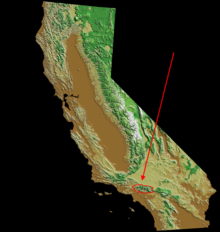bio.wikisort.org - Plant
Symphyotrichum greatae (formerly Aster greatae) is a species of flowering plant in the family Asteraceae endemic to California and known by the common name Greata's aster.[4]
| Symphyotrichum greatae | |
|---|---|
 | |
Conservation status | |
| Scientific classification | |
| Kingdom: | Plantae |
| Clade: | Tracheophytes |
| Clade: | Angiosperms |
| Clade: | Eudicots |
| Clade: | Asterids |
| Order: | Asterales |
| Family: | Asteraceae |
| Tribe: | Astereae |
| Subtribe: | Symphyotrichinae |
| Genus: | Symphyotrichum |
| Subgenus: | Symphyotrichum subg. Symphyotrichum |
| Section: | Symphyotrichum sect. Occidentales |
| Species: | S. greatae |
| Binomial name | |
| Symphyotrichum greatae | |
 | |
| South slopes of the San Gabriel Mountains of California[3] | |
| Synonyms[2] | |
|
Aster greatae Parish | |
Description
Symphyotrichum greatae is a colonizing perennial herb growing from a long rhizome. It produces upright to erect stems usually 50 to 120 centimeters (1+3⁄4 to 4 feet) tall. The leaves are mostly oval in shape and pointed, the ones at the base up to 15 centimeters (6 inches) long. The leaves and parts of the stems are hairy.[3]
The inflorescence is an open array of flower heads amidst leaflike bracts. The flower head contains many pale violet to nearly white ray florets and a center of yellow disc florets. The fruit is a hairy cypsela.[3]

Distribution and habitat
Symphyotrichum greatae is endemic to the San Gabriel Mountains of Southern California, where it grows in damp areas in the canyons of the southern slopes above the Los Angeles Basin.[3]
Conservation
NatureServe lists it as Imperiled (G2) worldwide.[1]
Citations
References
- Allen, G.A. (2012). "Symphyotrichum greatae". In Jepson Flora Project (ed.). Jepson eFlora. The Jepson Herbarium, University of California, Berkeley. Retrieved 4 July 2021.
- NatureServe (3 June 2022). "Symphyotrichum greatae Greata's Aster". NatureServe Explorer (explorer.natureserve.org). Arlington, Virginia: NatureServe. Retrieved 17 June 2022.
- POWO (2019). "Symphyotrichum greatae (Parish) G.L.Nesom". Plants of the World Online. Royal Botanic Gardens, Kew. Retrieved 4 July 2021.
- USDA, NRCS (2014). "Symphyotrichum greatae". The PLANTS Database (plants.usda.gov). Greensboro, North Carolina: National Plant Data Team. Retrieved 6 December 2015.
External links
- Aster greatae in the CalPhotos photo database, University of California, Berkeley
Другой контент может иметь иную лицензию. Перед использованием материалов сайта WikiSort.org внимательно изучите правила лицензирования конкретных элементов наполнения сайта.
WikiSort.org - проект по пересортировке и дополнению контента Википедии
